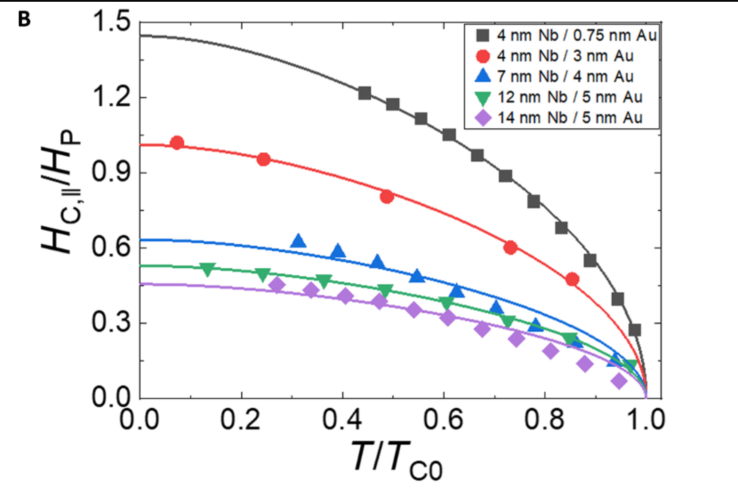 Hardware Tutorial
Hardware Tutorial
 Hardware News
Hardware News
 Higher-temperature superconductors inch closer to reality, thanks to new unconventional interface
Higher-temperature superconductors inch closer to reality, thanks to new unconventional interface
Higher-temperature superconductors inch closer to reality, thanks to new unconventional interface

A team of researchers have engineered a unique interface between a superconductor (material exhibiting zero electrical resistance at low temperatures) and a chiral material. The new interface creates a significantly enhanced Zeeman field - a magnetic field that affects the spin of electrons. The tech could be key for new and innovative applications in fields such as electronics, energy, and most importantly,quantum computing.
The novel superconducting material combines a conventional superconductor with a material exhibiting strong spin-orbit coupling. This interaction, which arises from the coupling between an electron's spin and its orbital motion, has been shown to strongly affect superconducting material properties. The interface induces spin polarization at the superconductor surface and generates magnetic origin quasiparticle states.
Now, quasiparticle states are those that are specifically influenced by magnetic fields. These states can arise in materials where the interactions between electrons and magnetic fields are strong. The effects are linked to the concept of chirality-induced spin selectivity (CISS), where a material's structural chirality influences the spin and orbital angular momentum of its electrons. CISS is crucial for developing superconducting spintronics and topological superconductivity, because it provides a way to control the spin of electrons in superconducting materials.
By engineering the interface between these two materials, the researchers were able to enhance the superconducting properties. The resulting material also demonstrated a way higher tolerance to magnetic fields, which in itself is a critical factor for many practical applications. For instance, it can eliminate decoherence, which occurs when a quantum system interacts with its environment.
The implications? This new tech can contribute towards the development of high-temperature superconductors, which operate at temperatures closer to ambient conditions. It's important to note that existing superconductors only work at extremely low temperatures. If temperatures rise high enough that the conduction band is reached, superconductivity will not occur.Therefore, future materials based on said interface could redefine energy transmission and storage, as well as enable the creation of more powerful and efficient electronic devices, like high-performance transistors.
Lastly, the enhanced spin-orbit coupling in this new material could lead to the realization of exotic superconducting states with topological properties. Exotic states differ from conventional superconductors in terms of their electronic properties and symmetry. These states have been the subject of intense research interest due to their potential for information processing and quantum computation, as mentioned earlier.
The researchers believe that their findings will stimulate further research into the field of superconductivity and open up new avenues in the near future. For reference, the first commercial MRI system using superconductors was introduced in the early 1980s. Needless to say, it was groundbreaking tech, and hopefully the future applications only build on its legacy.

The above is the detailed content of Higher-temperature superconductors inch closer to reality, thanks to new unconventional interface. For more information, please follow other related articles on the PHP Chinese website!

Hot AI Tools

Undresser.AI Undress
AI-powered app for creating realistic nude photos

AI Clothes Remover
Online AI tool for removing clothes from photos.

Undress AI Tool
Undress images for free

Clothoff.io
AI clothes remover

Video Face Swap
Swap faces in any video effortlessly with our completely free AI face swap tool!

Hot Article

Hot Tools

Notepad++7.3.1
Easy-to-use and free code editor

SublimeText3 Chinese version
Chinese version, very easy to use

Zend Studio 13.0.1
Powerful PHP integrated development environment

Dreamweaver CS6
Visual web development tools

SublimeText3 Mac version
God-level code editing software (SublimeText3)

Hot Topics
 Huawei Watch GT 5 smartwatch gets update with new features
Oct 03, 2024 am 06:25 AM
Huawei Watch GT 5 smartwatch gets update with new features
Oct 03, 2024 am 06:25 AM
Huawei is rolling out software version 5.0.0.100(C00M01) for the Watch GT 5 and the Watch GT 5 Prosmartwatchesglobally. These two smartwatches recently launched in Europe, with the standard model arriving as the company’s cheapest model. This Harmony
 Tekken\'s Colonel Sanders dream fried by KFC
Oct 02, 2024 am 06:07 AM
Tekken\'s Colonel Sanders dream fried by KFC
Oct 02, 2024 am 06:07 AM
Katsuhiro Harada, the Tekken series director, once seriously tried to bring Colonel Sanders into the iconic fighting game. In an interview with TheGamer, Harada revealed that he pitched the idea to KFC Japan, hoping to add the fast-food legend as a g
 Cybertruck FSD reviews praise quick lane switching and full-screen visualizations
Oct 01, 2024 am 06:16 AM
Cybertruck FSD reviews praise quick lane switching and full-screen visualizations
Oct 01, 2024 am 06:16 AM
Tesla is rolling out the latest Full Self-Driving (Supervised) version 12.5.5 and with it comes the promised Cybertruck FSD option at long last, ten months after the pickup went on sale with the feature included in the Foundation Series trim price. F
 Garmin releases Adventure Racing activity improvements for multiple smartwatches via new update
Oct 01, 2024 am 06:40 AM
Garmin releases Adventure Racing activity improvements for multiple smartwatches via new update
Oct 01, 2024 am 06:40 AM
Garmin is ending the month with a new set of stable updates for its latest high-end smartwatches. To recap, the company released System Software 11.64 to combat high battery drain across the Enduro 3, Fenix E and Fenix 8 (curr. $1,099.99 on Amazon).
 First look: Leaked unboxing video of upcoming Anker Zolo 4-port 140W wall charger with display
Oct 01, 2024 am 06:32 AM
First look: Leaked unboxing video of upcoming Anker Zolo 4-port 140W wall charger with display
Oct 01, 2024 am 06:32 AM
Earlier in September 2024, Anker's Zolo 140W charger was leaked, and it was a big deal since it was the first-ever wall charger with a display from the company. Now, a new unboxing video from Xiao Li TV on YouTube gives us a first-hand look at the hi
 New Xiaomi Mijia Graphene Oil Heater with HyperOS arrives
Oct 02, 2024 pm 09:02 PM
New Xiaomi Mijia Graphene Oil Heater with HyperOS arrives
Oct 02, 2024 pm 09:02 PM
Xiaomi will shortly launch the Mijia Graphene Oil Heater in China. The company recently ran a successful crowdfunding campaign for the smart home product, hosted on its Youpin platform. According to the page, the device has already started to ship to
 Samsung Galaxy Z Fold Special Edition revealed to land in late October as conflicting name emerges
Oct 01, 2024 am 06:21 AM
Samsung Galaxy Z Fold Special Edition revealed to land in late October as conflicting name emerges
Oct 01, 2024 am 06:21 AM
The launch of Samsung's long-awaited 'Special Edition' foldable has taken another twist. In recent weeks, rumours about the so-called Galaxy Z Fold Special Edition went rather quiet. Instead, the focus has shifted to the Galaxy S25 series, including
 Manjaro 24.1 \'Xahea\' launches with KDE Plasma 6.1.5, VirtualBox 7.1, and more
Oct 02, 2024 am 06:06 AM
Manjaro 24.1 \'Xahea\' launches with KDE Plasma 6.1.5, VirtualBox 7.1, and more
Oct 02, 2024 am 06:06 AM
With a history of over one decade, Manjaro is regarded as one of the most user-friendly Linux distros suitable for both beginners and power users, being easy to install and use. Mostly developed in Austria, Germany, and France, this Arch-based distro





